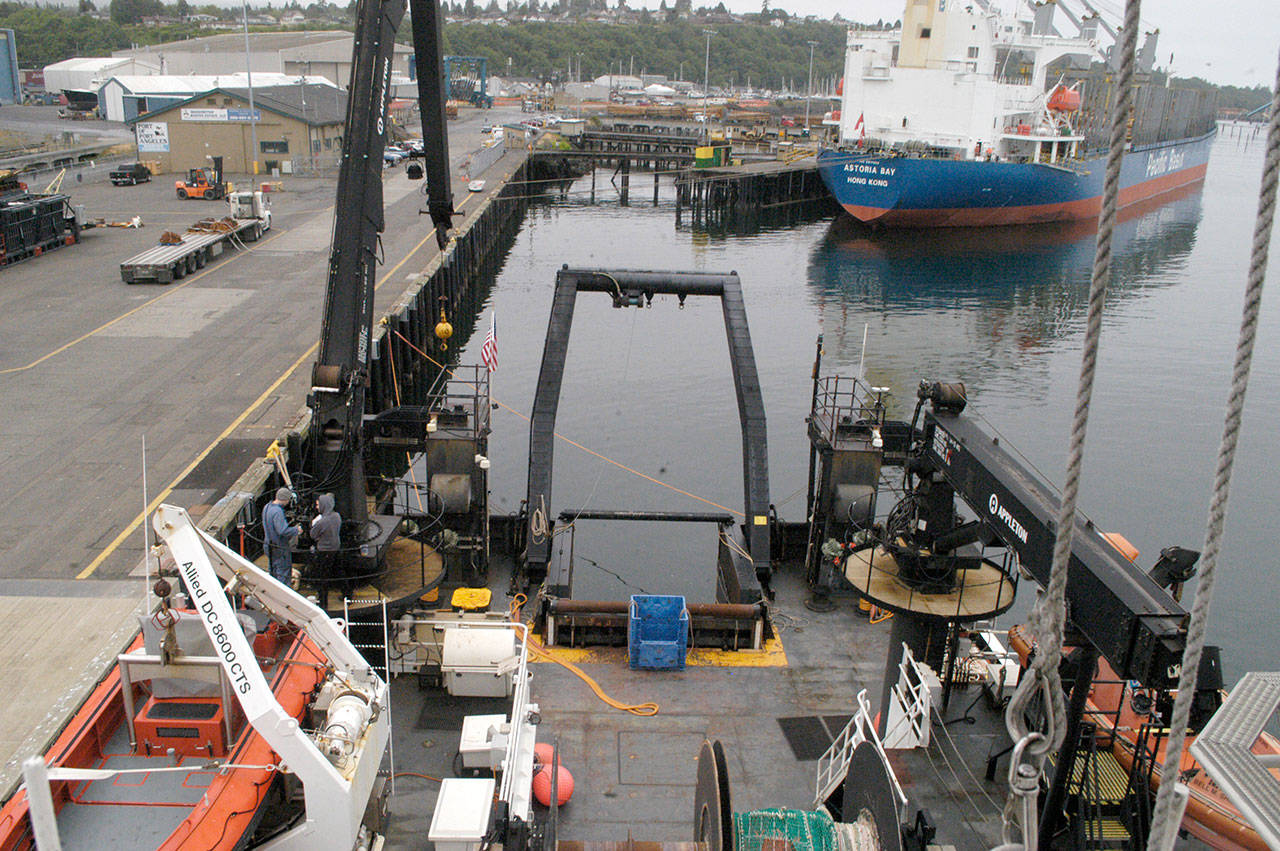By Rob Ollikainen
Peninsula Daily News
PORT ANGELES — A team of scientists set sail on a National Oceanic and Atmospheric Administration research vessel last week to study juvenile salmon and other fish in the Olympic Coast National Marine Sanctuary.
Standing in the wheelhouse was Capt. Jesse Stark, a Port Angeles native who was making a homecoming as the newly-assigned commanding officer of the Bell M. Shimada.
“It’s always good to come back home,” Stark said last Tuesday as the ship was docked at Port of Port Angeles’ Terminal 1.
“This is going to be a really interesting look at salmon,” said Jenny Waddell, Olympic Coast National Marine Sanctuary research coordinator, in a Tuesday interview on the Shimada.
“We’re really excited to learn more about the ocean phase of the salmon life cycle.”
The net surveys are part of an ongoing, 20-year effort to understand ecosystems and the biological and physical processes that influence salmon recruitment in the Pacific Northwest, NOAA officials said.
“Salmon is an iconic Northwest species, culturally and economically,” said Stark, a 1990 Port Angeles High School graduate who became commanding officer of the Shimada two weeks ago.
“I know a lot of the tribes depend on the resource. That’s really how I got my start in the maritime industry — working on the charter fishing fleet catching salmon.”
The salmon surveys are led by NOAA Fisheries and Northwest Fisheries Science Center with support from Bonneville Power Administration.
The Shimada crew planned to deploy a 20- by 30-meter net from the stern of the 209-foot vessel for trawls Wednesday, Thursday and Friday. They were looking for juvenile salmon and other critters in the surface layer of the ocean.
Salmon captured in the trawls were to be returned to the sea after a period of rest.
At night, Waddell planned to use smaller “bongo” nets to collect and analyze zooplankton, an important part of the food web and a barometer of oceanic conditions.
The plan was to conduct daily surface trawls along cross-continental shelf transects with Frosti, a NOAA-contracted fishing trawler, to compare research and calibrate survey results.
The pre-established transects run east to west some 30 miles offshore from points originating near Cape Alava, La Push and the mouth of the Queets River, Waddell said.
“The objective of the research trawls is to understand the abundance and distribution of pelagic fishes, including juvenile salmon, and relate those variables to properties of the ocean environment and to the abundance and distribution of prey upon which the young fish feed,” NOAA officials said in a statement about the cruise.
“This is part of a larger effort to understand the ecological drivers of ocean productivity generally and of salmon survival specifically.”
The bongo nets were deployed near the sanctuary’s deeper moorings, which are attached to instruments that measure things such as oxygen, temperature and salinity.
“We can use that information about the ocean and pair it with what we find out from the trawl,” Waddell said.
Technical staff from the Quileute Tribe’s Department of Natural Resources planned to sample surface water during the cruise for signs of harmful algal blooms and marine toxins such as domoic acid, NOAA officials said.
Shimada returned to her home port in Newport, Ore., on Saturday. The results of the survey will be published in a scientific paper at a later date, Waddell said.
Some crew members were to be assigned to the observation deck above Shimada’s spacious bridge to keep watch for whales and other marine mammals.
Ships are required to steer clear of marine mammals to prevent strikes.
“We take it very seriously,” Waddell said while climbing the stairs to the top deck.
Commissioned in 2010, the Bell M. Shimada is one of five NOAA fisheries vessels built to meet specific data collection requirements and standards for a low acoustic signature, according to NOAA’s Office of Marine and Aviation Operations.
The ship can hold a crew of 24 with room for 17 scientists, Stark said.
Stark said his Port Angeles roots weighed into his decision to remain on the West Coast.
After high school, Stark earned a fisheries degree from Peninsula College and continued to spend his summers and holidays working aboard the MV Coho ferry.
Stark worked on the NOAA ship Rainier in the summer of 1998 and joined the NOAA Corps in 1999.
His land assignments have included oil spill response coordination.
Two of Stark’s high school classmates became polar tanker captains and another former schoolmate now runs a fuel barge, he said, adding that he still has friends working on the Coho.
“There’s a fair number of people from Port Angeles who are in the maritime industry,” Stark said.
The Shimada crew will conduct fishing trawls in the Cordell Bank and Greater Farallones national marine sanctuaries in California in July before returning to the Pacific Northwest for more research in August.


